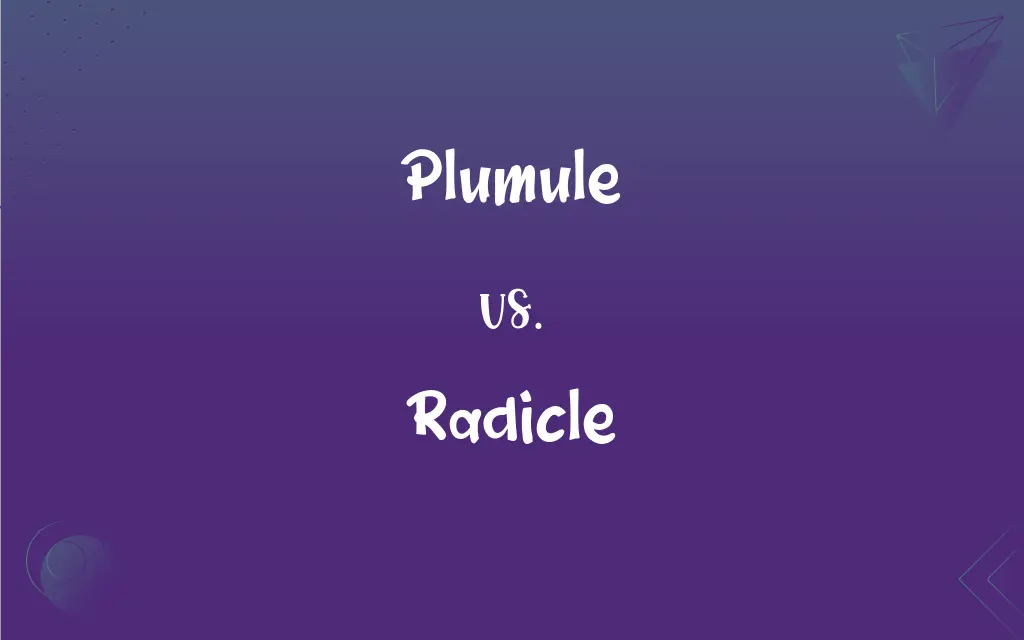Plumule vs. Radicle: What's the Difference?
Edited by Janet White || By Harlon Moss || Updated on October 28, 2023
Plumule is the embryonic shoot, while radicle is the embryonic root of a seedling.

Key Differences
The plumule and radicle are essential parts of a germinating seed. The plumule is the embryonic shoot, which eventually develops into the stem and leaves of the plant. On the other hand, the radicle is the embryonic root that penetrates the soil to anchor the seedling.
Both the plumule and radicle play critical roles in the initial stages of plant growth. The plumule heads upward towards the light, allowing the plant to photosynthesize and produce food. In contrast, the radicle delves downward into the ground, facilitating the uptake of water and nutrients necessary for growth.
These two parts of the seedling emerge during germination. As the seed absorbs water, the radicle is usually the first to protrude from the seed coat, seeking a firm footing in the soil. Following this, the plumule unfolds and begins its journey upwards.
The development and health of both the plumule and radicle are crucial for the survival of the plant. A compromised plumule can hinder the plant's ability to access sunlight, while a damaged radicle can reduce the plant's capacity to absorb essential resources from the soil.
In summary, the plumule and radicle are foundational components of a germinating seed. While the plumule is tasked with upward growth and photosynthesis, the radicle is responsible for anchoring the plant and absorbing ground resources.
ADVERTISEMENT
Comparison Chart
Function
Develops into the stem and leaves.
Develops into the primary root.
Direction
Grows upwards.
Grows downwards.
Appearance
Typically green and leaf-like.
Thread-like and often white or pale in color.
First Act
Emerges after the radicle during germination.
Usually the first part to emerge from a seed.
Role
Photosynthesis and accessing light.
Anchoring and nutrient absorption.
ADVERTISEMENT
Plumule and Radicle Definitions
Plumule
A tiny bud that grows into the plant's stem and leaves.
As the seed germinated, the plumule began its upward journey.
Radicle
The initial structure that absorbs water and nutrients for the seedling.
The seed's radicle rapidly extended to tap into the soil's resources.
Plumule
The embryonic shoot in a seed.
The small plant's plumule started to show, promising future leaves and stems.
Radicle
The counterpoint to the plumule in a germinating seed.
While the plumule shoots up, the radicle burrows down.
Plumule
The initial growth point for the aerial parts of a plant.
The gardener pointed out the plumule to the students, highlighting its importance.
Radicle
The embryonic root that anchors the seedling.
Without a healthy radicle, the plant wouldn't have a strong foundation in the ground.
Plumule
The counterpart to the radicle in seed germination.
While the radicle seeks the ground, the plumule reaches for the sky.
Radicle
The first root to emerge from a germinating seed.
The radicle pushed through the seed coat, seeking the soil below.
Plumule
The first indication of shoot development in a germinating seed.
Upon close examination, one could see the delicate plumule starting to unfold.
Radicle
A primary root that emerges directly from a seed.
The radicle's growth is a vital first step in a plant's life cycle.
Plumule
A down feather.
Radicle
(Botany) The part of a plant embryo that develops into a root.
FAQs
What is a plumule?
A plumule is the embryonic shoot in a seed that develops into the stem and leaves.
How does a radicle differ from a plumule?
The radicle is the embryonic root of a seedling, while the plumule is the embryonic shoot.
How does the radicle assist the plant?
The radicle anchors the seedling and absorbs water and nutrients from the soil.
Do all plants have a distinct plumule and radicle during germination?
Most seed plants exhibit a distinct plumule and radicle during germination, but the visibility and appearance can vary.
Which emerges first during seed germination, the plumule or radicle?
The radicle typically emerges first, followed by the plumule.
What happens if the radicle is damaged?
A damaged radicle can reduce the plant's capacity to absorb essential resources from the soil.
Why is the plumule green?
The plumule is green due to the presence of chlorophyll, essential for photosynthesis.
Are the functions of the plumule and radicle interconnected?
Yes, while the plumule focuses on accessing light, the radicle ensures the plant has resources from the soil.
Can the plumule function without the radicle?
It's challenging, as the radicle provides essential water and nutrients to the developing plant.
Can a seed grow without a healthy plumule?
A compromised plumule can hinder the plant's growth by limiting its access to sunlight.
Is the plumule visible in all seeds?
Not always. The plumule becomes visible during the germination process in most seeds.
What role does the radicle play in seed germination?
The radicle is usually the first to emerge from the seed coat, anchoring the seedling.
How soon after planting can you see the plumule and radicle?
It varies among seeds, but usually, the radicle emerges first shortly after germination, followed by the plumule.
Why is the plumule important?
The plumule is vital for photosynthesis as it grows into the plant's stem and leaves.
How deep can a radicle grow?
The depth varies among plants, but the radicle grows downward to establish a firm root system.
Can you identify the plumule on a germinated seed?
Yes, it is typically green and leaf-like, growing opposite to the radicle.
What is the shape of a typical radicle?
The radicle is usually thread-like and can be white or pale in color.
Can the direction of plumule growth change?
The plumule typically grows upwards, seeking light for photosynthesis.
Is the radicle always visible on a germinated seed?
In most cases, yes. The radicle is the initial growth from a seed, appearing as a thread-like structure.
What happens if the radicle doesn't penetrate the soil?
If the radicle doesn't penetrate the soil, the plant may not receive the necessary water and nutrients.
About Author
Written by
Harlon MossHarlon is a seasoned quality moderator and accomplished content writer for Difference Wiki. An alumnus of the prestigious University of California, he earned his degree in Computer Science. Leveraging his academic background, Harlon brings a meticulous and informed perspective to his work, ensuring content accuracy and excellence.
Edited by
Janet WhiteJanet White has been an esteemed writer and blogger for Difference Wiki. Holding a Master's degree in Science and Medical Journalism from the prestigious Boston University, she has consistently demonstrated her expertise and passion for her field. When she's not immersed in her work, Janet relishes her time exercising, delving into a good book, and cherishing moments with friends and family.
































































